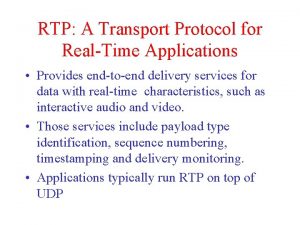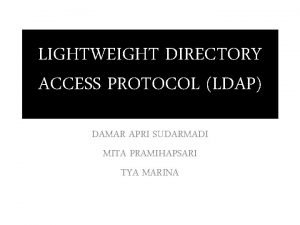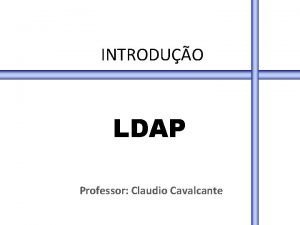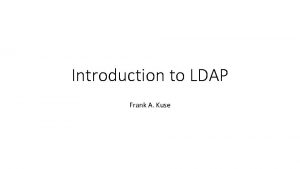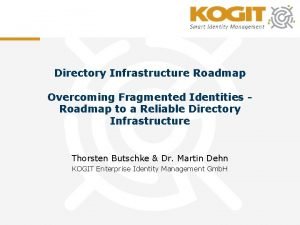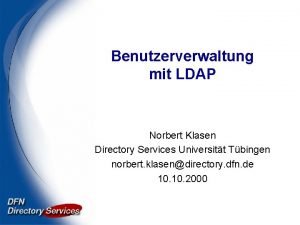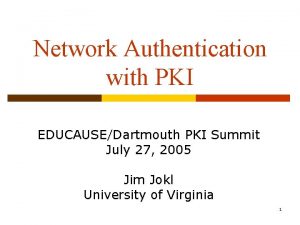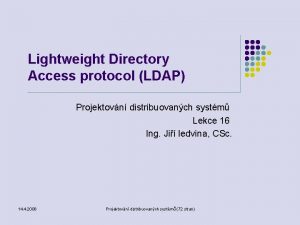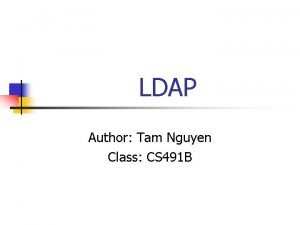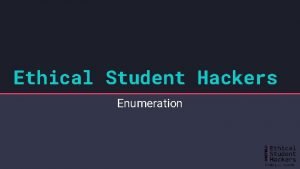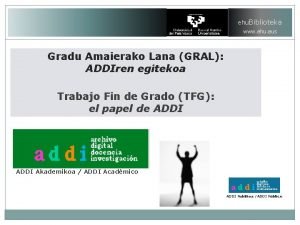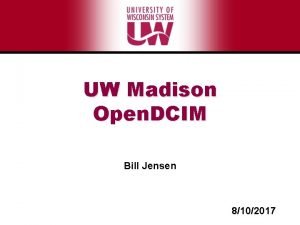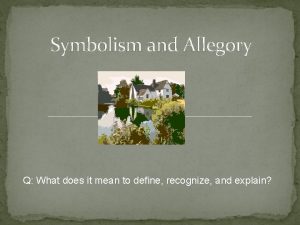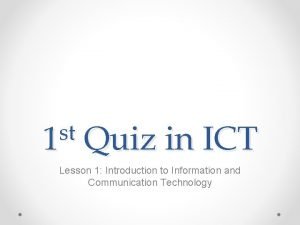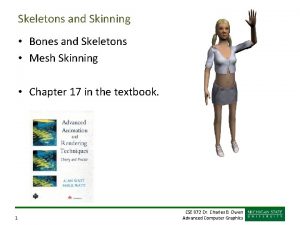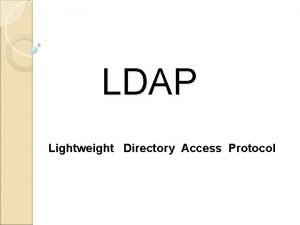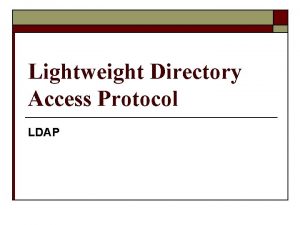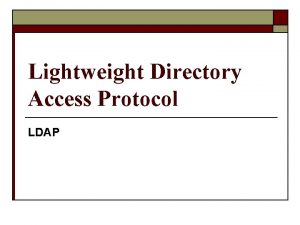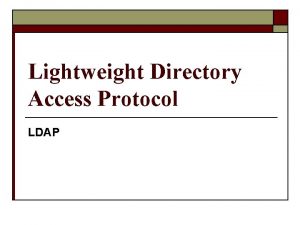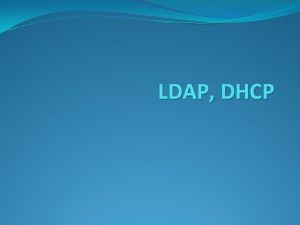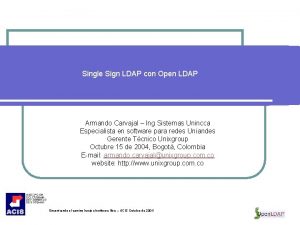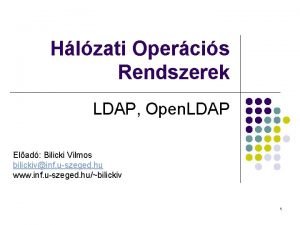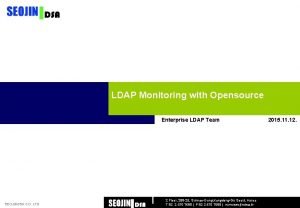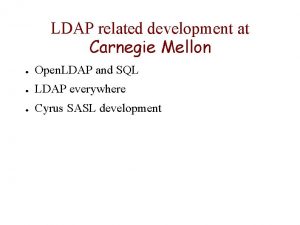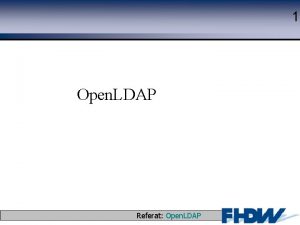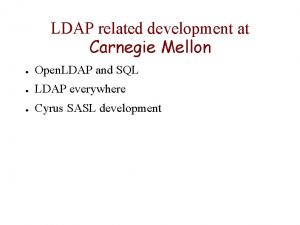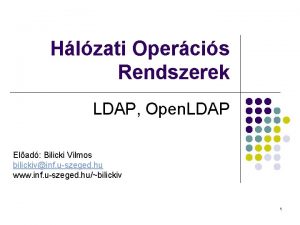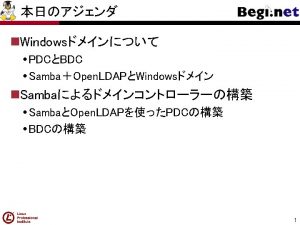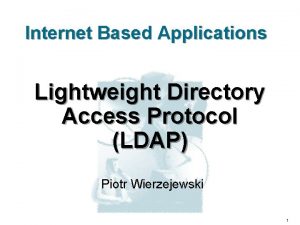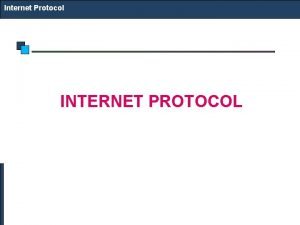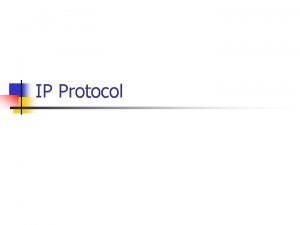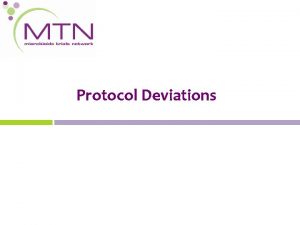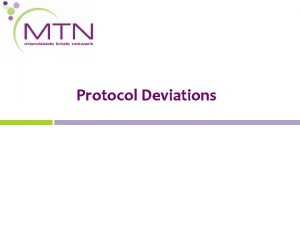LDAP Protocol and Applications Role of LDAP Allow

























- Slides: 25

LDAP- Protocol and Applications

Role of LDAP • Allow clients to access a directory service • Directories hold hierarchical structured information • Clients may be directly controlled by individuals, embedded in applications, or “agents” • LDAP can be used when integrating multiple directory services

Advantages of LDAP • • • Global naming model ensures unique entries Allows for multiple independent directories Extensible to meet future / local requirements Runs directly over TCP / IP and SSL Has broad industry support Based on existing deployed technologies

Overview • Client-server architecture • Global tree of entries, each server holds a portion of the tree • Entry: set of attributes with distinguished name – Name: “cn=Mark Wahl, dc=critical-angle, dc=com” – Attributes: description, email address, photograph, etc • Operations – – Bind: identify the client and optionally authenticate Search: find entries in a portion of the tree matching a filter Add, delete, modify DN: modifies the tree Extended operations: for application-specific functionality

Components HTTP Client LDAP-X. 500 Gateway X. 500 Server HTTP Client WWW-LDAP Gateway LDAP Server

Evolution • • • 1988: X. 500 1992: Univ. Michigan starts developing LDAP 1993: LDAP first published as RFC 1995: Work begins on LDAPv 3 specification 1996: Final call on LDAPv 3 drafts 1997: LDAPv 3 published as RFCs

New in LDAPv 3 • • Referrals Character sets Schema definitions Schema publication Security features Extended operation framework Dynamic and paged search extensions

LDAPv 3: Referrals • LDAPv 2 – Every server required to process any query – Based on initial use of LDAP as lightweight access to X. 500 • LDAPv 3 – Server may process query itself, or return a referral – Referral: set of URLs of other servers to contact – Multiple URLs can be included, in case servers are inaccessible – Servers can also rewrite queries for clients – Referral processing is done inside client library and can be transparent to applications

LDAPv 3: Character Sets • LDAPv 2 only allowed for ASCII and T. 61 – Based on legacy of X. 500 environment – T. 61 can represent only some Western European characters • LDAPv 3: UTF-8 entry names and attribute values – UTF-8 is a variable-length encoding of ISO 10646 – ASCII characters are identical in UTF-8 – Unicode is a subset of ISO 10646

LDAPv 3: Schema Definitions • Schema – Aspects of a real-world object to be represented in entry – No schema defined for LDAPv 2, but X. 500 implied • LDAPv 3 suggests: – X. 500(1993): people and organizations – RFC 1274 updated: Internet-specific attributes • Vendor-defined schema – Netscape, Microsoft, Novell and others • Application and administrator-defined schema – For local requirements

LDAPv 3: Schema Publication • Schema is extensible attribute type names are not globally unique • Clients can check their semantic associations to an attribute type name match those of server • Clients also need way to discover new schema • LDAPv 3 adds subschema subentries to the tree which contain description and unique identifiers • Automatically maintained by servers themselves

LDAPv 3: Security • LDAPv 3 can be carried over SSL – Provides connection authentication and confidentiality • SASL Bind – Allows negotiation of services (e. g. Kerberos or GSS-API) • Password encrypted with one-way hash – All servers must have a copy of client’s password – Suitable for environments with a single service • Strong authentication with digital signature – Servers need only have client’s public key (via certificate) – Suitable for environments with multiple services

LDAPv 3: Extension Framework • Extension – Supports adding new features to LDAP without disruption • Unique identifier, criticality, value – Server may ignore unrecognized non-critical extensions – Server rejects operation with unrecognized critical extensions • Client can check server’s supported extensions – Published in the directory tree in a special entry

LDAPv 3: Paged Search Results • Optional server feature • Server sorts result and caches it • Clients can request arbitrary pages (subsets) of a recently gathered result • Designed for UI clients: to support a user moving scrollbar around a long list of entries

LDAPv 3: Dynamic Refresh • Optional server feature • Client adds information to the directory, and requests that the server time it out • Server replies with time-to-live, based on its load • Client sends UDP / IP refresh operation to server • If client shuts down, server will delete information • Designed for mobile and dial-up clients

Some Applications of LDAP • Internet applications – Centralized or distributed white pages – ISP on-line subscriber directory • Intranet applications – Internal white pages – Certificate and CRL distribution – System/network management database

Applications: White Pages • • For use by people through WWW gateways/clients Telephone number, email address lookup Can also return photos, spoken names, URLs Naming and distribution model allows the directory to contain information from multiple organizations • PARADISE: over 1, 000 entries maintained by Universities and research organizations • Big. Foot, Four 11, others provide LDAP access

Applications: White Pages • • Same data can be used by programs Sendmail extension checks LDAP for addressing Netscape, other WWW servers validate user Directory synchronization: combining address databases from multiple mail systems

Applications: Users Directory • Dynamic directory extension can be used where information is frequently changing • Microsoft Net. Meeting and other clients will register user in directories of everyone on-line • Other people can search for that user, based on their name or other attributes • Terminal capabilities can be determined from directory before communication starts

Applications: Certificates • Certificates and Revocation Lists are exchanged between components of Public Key Infrastructure • Users and Certification Authorities (CAs) identified by Distinguished Names, as used in LDAP • Programs can automatically retrieve this information from LDAP-capable directories • LDAPv 2 could not handle certificates correctly; fixed in LDAPv 3

Application: System Database • LDAP can be used to access directories of network components (servers, printers, etc) • Novell has a gateway from LDAP to NDS • Directories can also be built with other generalpurpose servers

Implementations • Few LDAPv 3 implementations available – Critical Angle, Zoomit; and others • LDAPv 2 implementations: – – Servers Client libraries Gateways to LDAP • From HTTP, Ph / CCSO, whois++, X. 500 – Gateways from LDAP • To X. 500, NDS – Firewalls

Some Implementations • Clients – Univ. Michigan, Microsoft, Netscape Communicator • Client libraries – C (RFC 1823), Java, Perl, Visual Basic, Tcl • General-purpose servers – Most X. 500 servers support LDAP – Netscape: LDAP-only Directory Server – Univ. Michigan, Critical Angle: free SLAPD • Single-purpose servers – Provide LDAP view onto existing data structure – Often not able to handle modifications or extensions

Future Directions • Replication and Indexing – Currently replication between servers not standardized – Replication will be defined using existing LDAP operations – Centroids: make wide-area searches more effective • Standard Access Control – Unless two vendor’s servers implement access control in the same way, cannot replicate sensitive information – Currently only X. 500 servers have a common model • Additional Schemas – Applications will take advantage of directory infrastructure

Conclusions • LDAP is key to the directory infrastructure • LDAP will be used by many services, just like TCP and DNS are today • LDAPv 3 implementations are coming • Be sure directory servers are suited for the service being deployed
 Rtp a transport protocol for real time applications
Rtp a transport protocol for real time applications Worker role azure
Worker role azure Ldap adalah
Ldap adalah Ldap
Ldap Introduction to ldap
Introduction to ldap Radiant logic ldap
Radiant logic ldap Mim
Mim Ldap benutzerverwaltung
Ldap benutzerverwaltung Uva netreg
Uva netreg Charles university faculty of humanities
Charles university faculty of humanities Co je ldap
Co je ldap Tam ldap
Tam ldap Rpcclient hacktricks
Rpcclient hacktricks Addi tfg
Addi tfg Opendcim demo
Opendcim demo Zeppelin ssl
Zeppelin ssl Krappmann modell
Krappmann modell Role conflict occurs when fulfilling the role expectations
Role conflict occurs when fulfilling the role expectations Hypothesis setting
Hypothesis setting Stalling objection
Stalling objection Hydrosphere facts
Hydrosphere facts What do we call a community of coral polyps
What do we call a community of coral polyps Lawn allow drawing swimmer
Lawn allow drawing swimmer Allegory example in literature
Allegory example in literature It provides a common framework to allow data to be shared
It provides a common framework to allow data to be shared Vertex bone
Vertex bone
